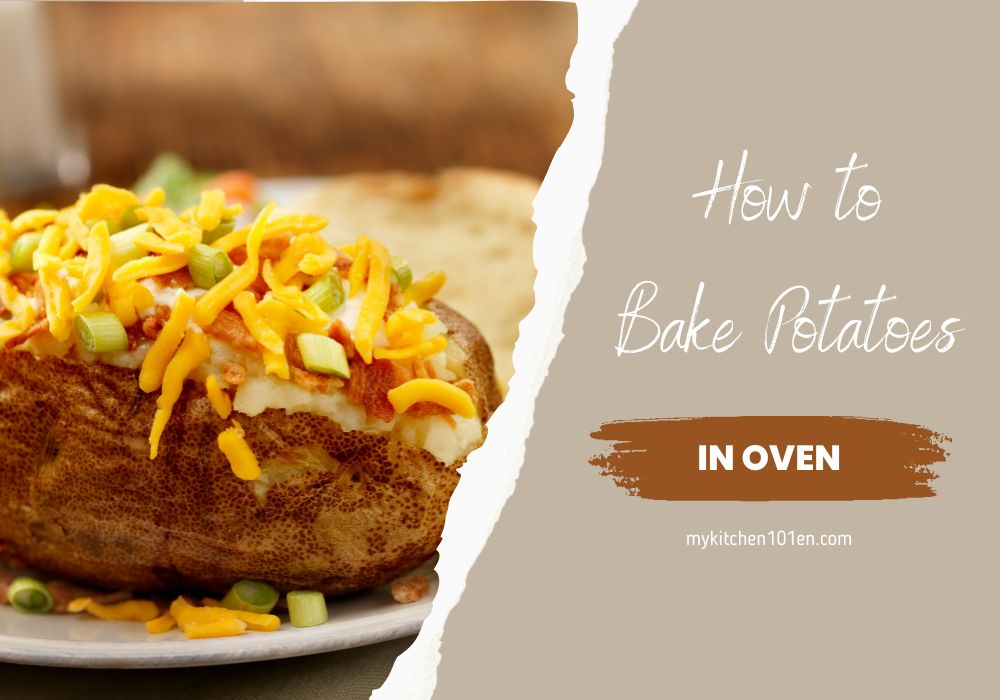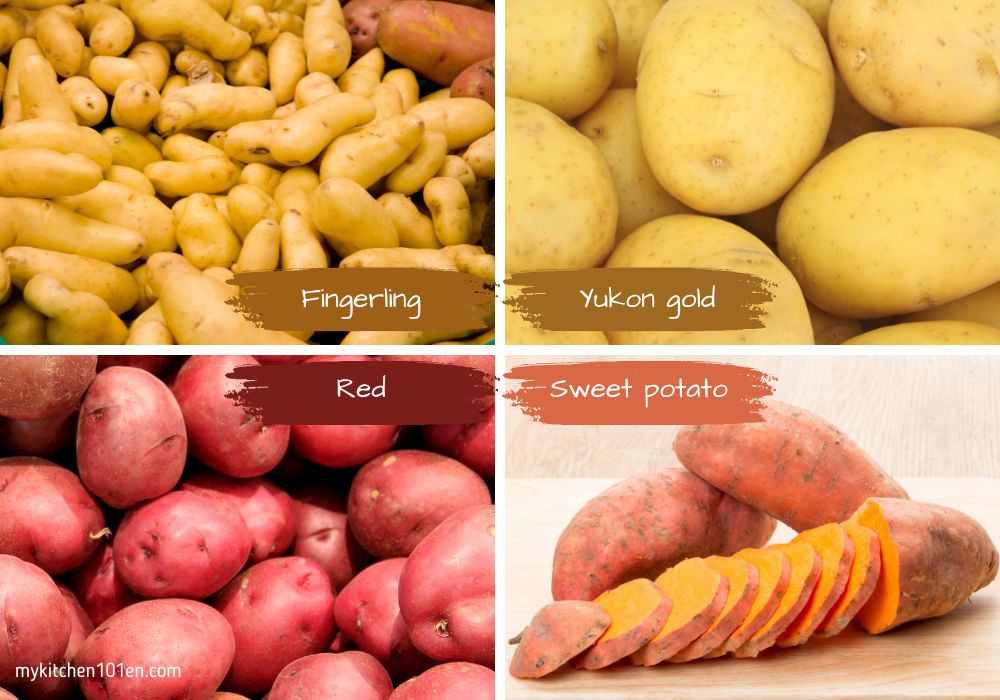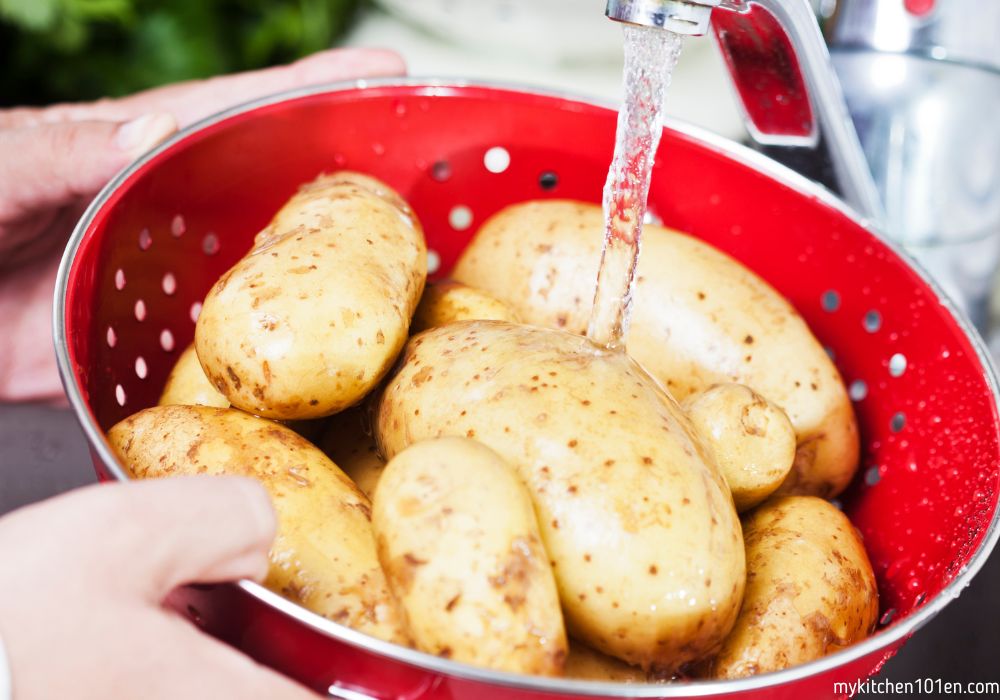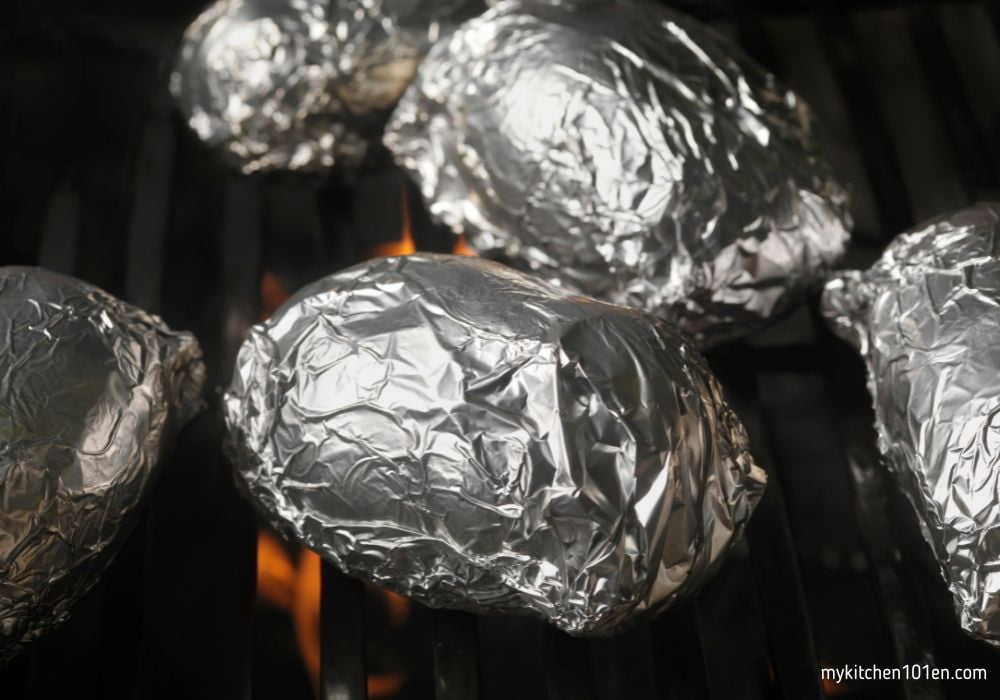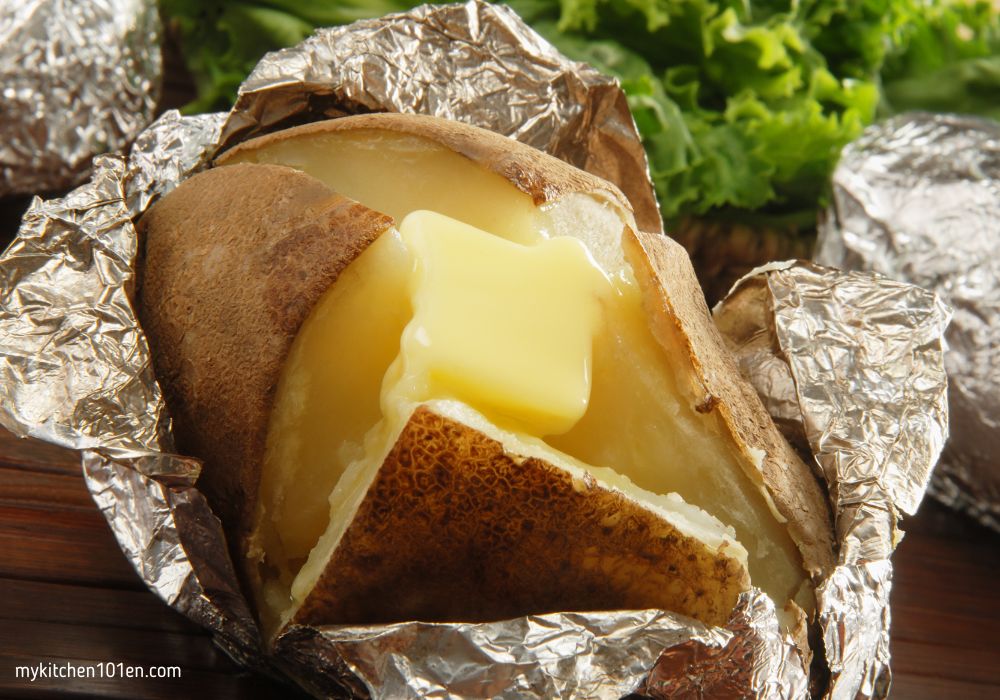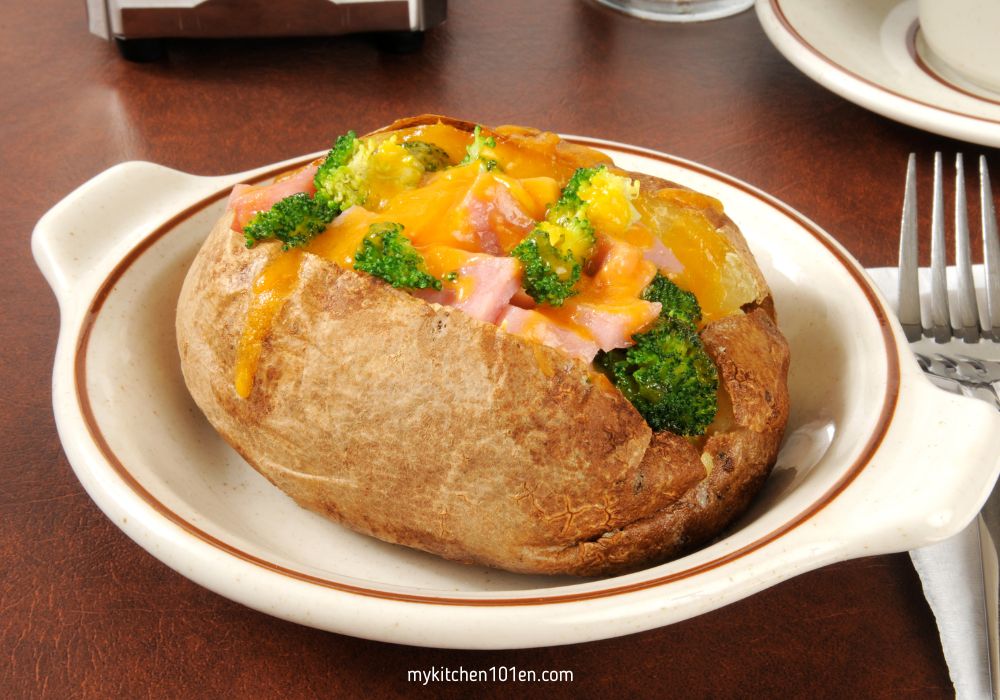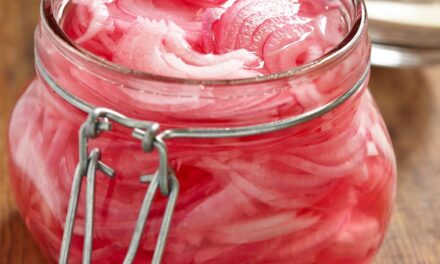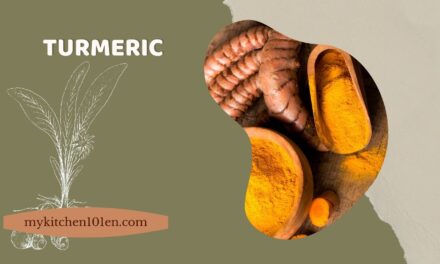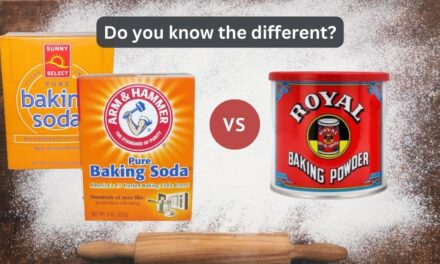I thought we could go back to the basics and discuss how to bake a potato—a skill that every good cook should know how to do.
Baking a potato is one of the easiest ways to prepare a healthy dinner side dish. You can bake them with just about anything—butter, sour cream, chives, and bacon bits are all great options.
Table of Contents
The Benefits of Baking Potatoes in an Oven
There are several advantages to baking potatoes in the oven rather than boiling or microwaving them.
- Baking potatoes give their outside a crispy skin while keeping their insides soft and fluffy. This texture combination is what makes them so delicious!
- Baking potatoes takes minimal effort. Once they’re seasoned and placed in the oven, you never have to worry about monitoring them like when boiling or frying—the oven does all of the work for you!
- Baking is a healthier cooking method than frying because it doesn’t require additional oils or fats.
My Heartfelt Baked Potato Story: From Oven to Table
Growing up, my family would have baked potato night at least once a week. It was always one of my favorite meals! My dad would wash and poke holes in each potato before rubbing them with oil and sprinkling salt over them.
Then he’d place them directly on the oven rack and we’d all eagerly wait for them to be ready. I remember squeezing each potato with an oven mitt to check if they were cooked through – this was always my job!
Once they were done, we’d cut them open and add butter, sour cream, cheese, chives – whatever toppings we wanted that night. It was a simple yet satisfying meal that brought our family together.
Fun fact: Did you know that baked potatoes were once used as hand warmers? During cold weather months in England in the 1800s people would put hot baked potatoes into their pockets to keep their hands warm!
What kind of potatoes are best for baking?
For me, baking a perfect baked potato is all about choosing the right type of potato.
It is possible with almost any type of potato—technically. But for the best-baked potatoes, Russets and Idaho work best. Their high starch content and low moisture levels mean that baked potatoes keep their fluffy and light texture on the inside. They also become crispy, thanks to their low moisture level.
I prefer to use medium-sized potatoes that are roughly the same size as they will cook evenly. Potatoes that are too small will dry out before cooking through, while those that are too large may not be done in time.
Make sure your potatoes have a uniform shape so they can cook evenly. If your potato has any bumps or irregularities on its surface, don’t be surprised if you get a baked potato that is unevenly cooked or even burning in certain areas of the potato.
| Type of Potato | Starch Content | Texture | Best for Baking? | Notes |
|---|---|---|---|---|
| Russet | High | Fluffy | Yes | Most popular choice for baking due to its high starch content and resulting fluffy texture. |
| Idaho | High | Fluffy | Yes | Similar to Russet potatoes, Idaho potatoes are great for baking because of their high starch content. |
| Yukon Gold | Medium | Creamy | Good | Can be used for baking, but will have a slightly creamier texture compared to Russet and Idaho potatoes. |
| Red | Low | Waxy | No | Better for boiling or making potato salads, as their waxy texture doesn’t produce the desired fluffy interior for baking. |
| Fingerling | Low | Waxy | No | Better suited for roasting or pan-frying due to their small size and waxy texture. |
| Sweet Potato | Medium | Smooth | Good | While different from the traditional baked potato, sweet potatoes can be baked and produce a smooth, velvety texture. |
Preparing the Potatoes for baking
Before we start to cook, the ingredients must be prepared. In this case, the potatoes have to be nicely prepared before it enters the oven.
1. Wash and Dry the Potatoes Thoroughly
Before baking your potatoes, let’s make sure you give your potatoes a nice and clean wash. Rinse under running water and be sure to scrub any dirt or debris off of the skin.
After washing, pat dry the potatoes with a clean towel or paper towel to absorb excess moisture. This helps your potatoes cook evenly so they’re not soggy in the center and overcooked on the outside!
Now, your potatoes are ready to go to the next process.
2. Poke Holes in Them with a Fork to Allow Steam to Escape
Poking holes in your potatoes is an important step in preparing them for baking. To do this, simply take a fork and gently poke several holes all over each potato.
These holes allow steam to escape while cooking, which helps prevent the potato from bursting and making a mess in the oven.
The tradition of poking holes in potatoes before baking them began as a safety measure. In the past, potatoes occasionally exploded in the oven due to steam buildup inside the unbroken skin.
3. Rub Them with Oil and Sprinkle with Salt for Added Flavor
While there is nothing wrong with plain baked potatoes, adding oil and salt can really enhance their flavor.
Start by coating each potato in a light layer of oil – this will help give the skin that crispy texture that we all love. You can use any type of oil you prefer.
Sprinkle some salt over each potato before placing them in the oven. This will bring out the natural flavors of both ingredients while adding some extra seasoning to your dish.
By following these simple steps for preparing your potatoes before baking, you’ll ensure that they turn out perfect every time. Not only will they taste great—but their crispy skin and fluffy insides are sure to impress!
How to Perfectly Bake a Potato in the Oven
1. Preheating Your Oven to 400°F (205°C)
Set your oven temperature to 400°F (205°C) and let it preheat. Preheating the oven is important as it helps with even cooking your potatoes.
2. Place Potatoes Directly on the Oven Rack or on a Baking Sheet Lined with Foil
If you opt for placing them directly on the oven rack, ensure that there is no drip pan underneath as this will prevent proper cooking.
This method allows for better air circulation around them, which results in evenly cooked potatoes. If you decide to use a baking sheet, line it with foil first to prevent sticking and make for easy cleaning afterward.
3. Bake for 45 Minutes to an Hour Depending on Size and Desired Doneness
Bake them according to their size and your desired doziness. Typically, small potatoes take around 45 minutes while large ones can take up to an hour.
To test for doneness, squeeze the potato to see if it is soft in the center. If so, remove from oven and set aside. Or, bake the potatoes until their skins pierce easily with a fork.
Keep in mind that different ovens will cook at different rates
Checking for Doneness
1. Using an Oven Mitt to Gently Squeeze Each Potato
Bake the potatoes for 45 minutes to an hour, then check if they’re done. To do this, gently squeeze one with a pot holder or oven mitt—if it’s soft but still holds its shape, you are good to go! If not continue cooking in 5 minutes increments until done (you will probably have to add more time than I did here). Do keep in mind that the potatoes will be extremely hot and can burn your hands if you touch them directly.
If you’re baking potatoes of different sizes, you may need to remove smaller ones earlier than larger ones.
2. Using a Knife or Fork to Check If They Are Cooked All The Way Through
You can also test if your baked potatoes are done by sticking a knife or fork into the center of one. If it goes in easily without resistance, then they’re cooked through.
If there is some resistance, return it to the oven and check its progress again in 5-10 minutes.
Be sure not to overcook your baked potatoes as they can turn dry and mealy.
Expert Tip: Wrapping Potatoes in Foil Affects Doneness Check
Some people like wrapping their potatoes in foil during baking, believing that it makes them cook faster and prevents skin from getting too crispy. However, this can make it harder to tell when they’re done since squeezing won’t give accurate results due to the extra layer of protection.
If you prefer to use foil, poke some holes in it for steam to escape and check doneness using a knife or fork.
Additionally, wrapping potatoes in foil can result in steaming instead of baking—and thus a less crispy skin than if they were left uncovered.
How to serve baked potatoes?
Now that you know how to check if your baked potatoes are done, it’s time for the fun part—toppings!
1. Cut Open Each Potato and Fluff Up the Insides with a Fork
Start by using a knife to cut open each potato lengthwise. Be careful not to slice all the way through, as you want to keep the potato intact.
Then, take a fork and gently fluff up the insides of each potato, separating the flesh into fluffy pieces that will be perfect for holding all your delicious toppings.
2. Topping suggestion for baked potato
When it comes to toppings for baked potatoes, there are endless possibilities.
- You may add a pat of butter on top of each potato – this will add richness and flavor.
- Sour cream is another classic topping that pairs perfectly with baked potatoes. You can also add shredded cheese for extra gooeyness or bacon bits for added crunch.
- If you’re looking for something a bit more creative, I’ll suggest adding chives or scallions on top of your finished potato – as both will add an herby freshness that pairs well with the earthy flavor of baked potatoes.
- Another fun option is to mix in some chopped vegetables like peppers or onions before adding your other toppings – this gives your dish an added dimension of flavor and texture.
| Topping Category | Topping Options | Notes |
|---|---|---|
| Dairy | Butter, sour cream, cheese | Classic choices that add richness and creaminess to the baked potato. |
| Fresh Herbs | Chives, parsley, cilantro | Add a burst of fresh flavor and a pop of color to your baked potato. |
| Proteins | Bacon bits, grilled chicken, turkey, pulled pork, tofu | Add protein to your baked potato to create a more filling and satisfying meal. |
| Vegetables | Broccoli, sautéed mushrooms, caramelized onions, bell peppers | Add a variety of textures and flavors to your baked potato by incorporating cooked veggies. |
| Healthier Alternatives | Greek yogurt, cottage cheese, hummus | Substitute traditional dairy toppings with healthier options for a lighter, more nutritious baked potato. |
| Sauces/Spreads | Salsa, chili, guacamole | Spice up your baked potato with flavorful sauces and spreads for a unique twist. |
In the 19th century, baked potatoes were sold by street vendors in London as an affordable and warming food option for the working class during the cold winter months.
Experiment With Your Own Unique Toppings
While traditional toppings like butter and sour cream are always delicious on baked potatoes, don’t be afraid to get creative! Experiment with different flavor combinations until you find something that really speaks to you.
Try adding crumbled feta cheese or diced tomatoes on top of your finished potato for a Mediterranean twist. Or mix in some cooked broccoli or spinach before adding shredded cheddar cheese and bacon bits – this will give your dish an added boost of nutrients and a savory flavor.
You can even try adding some hot sauce or salsa on top of your finished potato for a spicy kick. The key is to have fun and experiment until you find your favorite flavor combination!
The bottom line
There you have it, my friends! Baking potatoes in the oven is easy and the steps are a breeze to follow. The next time you’re craving a cozy meal, give these baked potatoes a try. I guarantee they’ll become a staple in your kitchen.
Happy baking, potato lovers! And remember, sometimes the simplest dishes bring the most joy to our hearts.
Baked potatoes have been a popular dish for centuries; they were even mentioned in a 16th-century English cookbook by Thomas Dawson.
FAQs for baked potato
Can I use any type of potato for baking?
While you can technically bake any type of potato, certain varieties are better suited for baking. Russet potatoes are the most popular choice, as their high starch content results in a fluffy interior. Yukon Gold and sweet potatoes are also good options. Do refer to the table above for other potatoes that are suitable for baking.
Do I need to wrap my potatoes in foil before baking?
Wrapping potatoes in foil is not necessary, and it can actually prevent the skin from getting crispy. I suggest baking them directly on a lined baking sheet to yield the best results.
How can I tell if my baked potatoes are done?
Insert a fork or a sharp knife into the center of the potato. If it slides in easily without any resistance, your potatoes are ready.
What are some popular toppings for baked potatoes?
Popular toppings include butter, sour cream, chives, cheese, bacon bits, and even chili or pulled pork.
Can I bake potatoes in a microwave or a slow cooker?
Yes, you can! However, the texture and taste may be different from oven-baked potatoes. Microwaved potatoes tend to have softer skin, while slow-cooked potatoes may not be as fluffy on the inside.
Can I bake my potatoes ahead of time and reheat them later?
Absolutely! It is possible to reheat potatoes that have been previously baked. Place the potato on a lined baking sheet, and heat it in a preheated oven for 15-20 minutes at 350°F (180°C). Or to make it easy, you can also reheat them in the microwave, but the skin may lose some of its crispiness.
Can I freeze baked potatoes for later use?
Yes. You can freeze baked potatoes, but their texture may change slightly upon reheating.
How do I store leftover baked potatoes?
Let your leftover baked potatoes cool completely. After that, wrap them with aluminum foil or plastic wrap and store them in the refrigerator. They will keep for up to four days.
Can I use different oils or seasonings for the potato skin?
Absolutely! You can use other oils like avocado oil or coconut oil if you don’t have olive oil or melted butter in hand. Feel free to get creative with your seasonings as well. Add in garlic powder, onion powder, paprika, or even your favorite spice blend to add extra flavor to the potato skin.
Is there a healthier alternative to the traditional toppings?
Yes, there are plenty of healthier topping options for baked potatoes. Try using Greek yogurt, cottage cheese, or even hummus for a healthier option. Top with fresh herbs like chives or cilantro, steamed or roasted veggies, and lean protein like grilled chicken, turkey, or tofu. The possibilities are endless!

